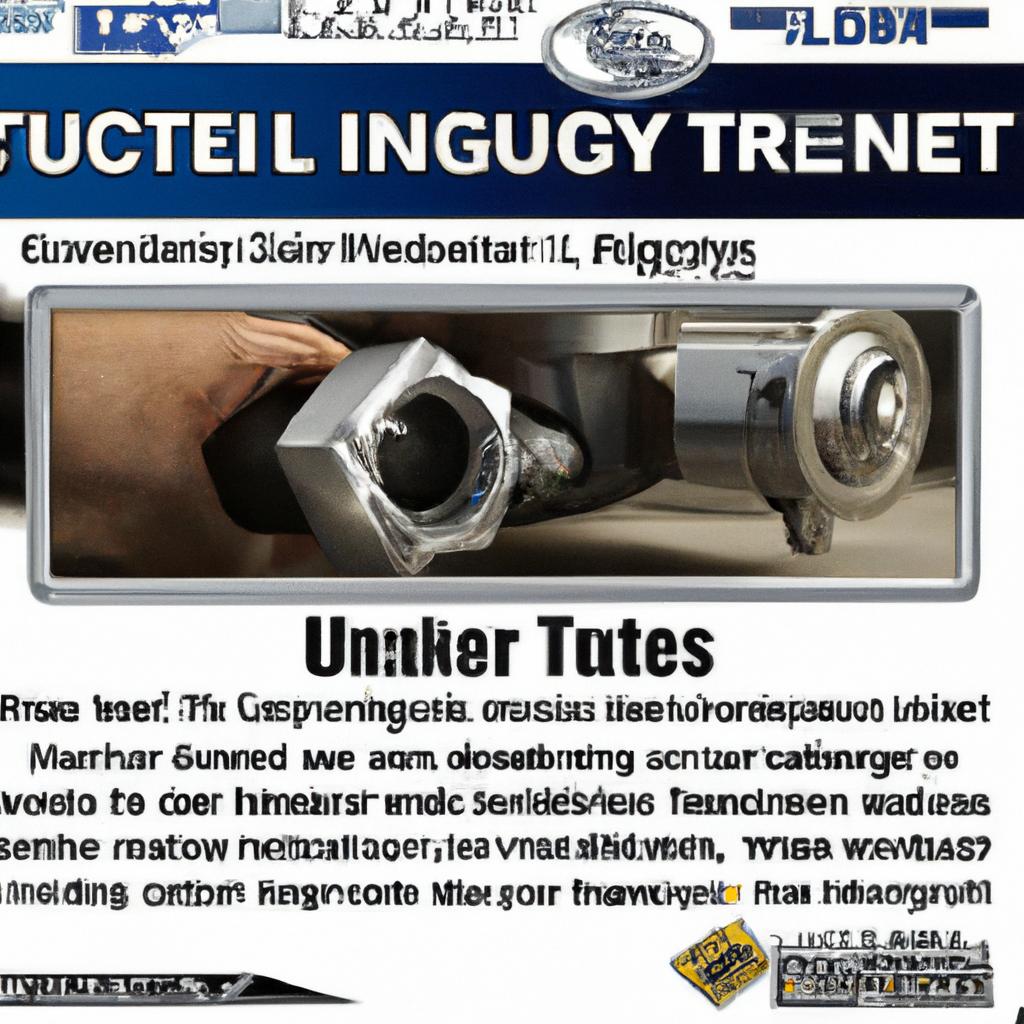Have you ever wondered about the correct torque to tighten lug nuts? It’s a question that many drivers often overlook, but getting it wrong could have serious consequences. In this article, we will explore the importance of using the proper torque and the potential risks of under or over-tightening lug nuts. So, if you want to ensure the safety of your wheels and prevent any unexpected mishaps on the road, read on to discover the essential guidelines for securing lug nuts with the right amount of torque.
Importance of Proper Torque for Tightening Lug Nuts
Proper torque is crucial when it comes to tightening lug nuts on your vehicle’s wheels. It not only prevents wheel damage but also avoids lug nut loosening, ensures safety, and maintains wheel alignment. Neglecting the correct torque specifications can lead to serious consequences, including accidents and costly repairs. Therefore, it is essential to understand the factors that affect torque requirements and follow the recommended torque specifications for a safe and smooth ride.
Preventing Wheel Damage
One of the primary reasons for using the proper torque when tightening lug nuts is to prevent wheel damage. Over-tightened lug nuts can put extreme stress on the wheel studs, causing them to stretch or even break. On the other hand, under-tightened lug nuts may cause the wheel to become loose, leading to vibration, uneven tire wear, and potential accidents. By applying the correct torque, you ensure that the wheel is securely fastened to the hub, reducing the risk of wheel damage.
Avoiding Lug Nut Loosening
Improper torque can also result in lug nut loosening, which poses a significant safety hazard. Loose lug nuts can cause the wheel to wobble or even detach from the vehicle while driving. This can lead to loss of control, accidents, and injuries. By tightening the lug nuts to the recommended torque, you ensure that they remain securely fastened, minimizing the chances of lug nut loosening.
Ensuring Safety
Safety should always be a top priority when it comes to any aspect of vehicle maintenance. The correct torque for tightening lug nuts plays a vital role in ensuring the safety of both you and your passengers. Properly tightened lug nuts maintain the structural integrity of the wheel assembly, reducing the risk of wheel detachment and accidents. By following the recommended torque specifications, you contribute to a safer driving experience for everyone on the road.
Maintaining Wheel Alignment
Proper torque for lug nuts also helps maintain wheel alignment. When the lug nuts are evenly tightened to the specified torque, the wheel sits flush against the hub, ensuring proper alignment. This alignment is crucial for even weight distribution, smooth handling, and optimal tire performance. Incorrect torque can disrupt the alignment, leading to uneven tire wear, poor handling, and decreased fuel efficiency. By tightening lug nuts to the proper torque, you promote consistent wheel alignment and enhance overall driving performance.
Factors Affecting Torque Requirements
Several factors influence the torque requirements for tightening lug nuts. Understanding these factors is essential to ensure that you are applying the correct torque for your specific wheel and lug nut combination. Here are some crucial factors to consider:
Thread Size and Pitch
The thread size and pitch of the wheel studs determine the amount of torque required to properly fasten the lug nuts. In general, larger thread sizes and finer pitches demand higher torque values, while smaller sizes and coarser pitches require less torque. It is essential to consult your vehicle’s manual or the lug nut manufacturer’s specifications to determine the appropriate torque range based on the thread size and pitch of your wheel studs.
Wheel Material
The material from which your wheels are made can affect the torque requirements for tightening lug nuts. Different materials, such as steel, aluminum alloy, or carbon fiber, have varying degrees of strength and elasticity. Steel wheels generally require higher torque due to their higher tensile strength, while aluminum alloy wheels often have lower torque requirements. Carbon fiber wheels, being lightweight and strong, may have unique torque specifications provided by the manufacturer. Paying attention to the specific material of your wheels is crucial to ensure proper torque application.
Wheel Coating
Some wheels feature coatings, such as paint or chrome plating. These coatings can affect the friction between the wheel and the lug nut, influencing the torque requirements. Coated wheels may require slightly higher torque values compared to bare metal wheels to ensure a secure fit. The lug nut manufacturer or your vehicle’s manual can provide guidance on adjusting torque values based on the type of wheel coating you have.
Lug Nut Type
Different types of lug nuts have varying torque specifications. Conical seat lug nuts, commonly used on most vehicles, typically require a specific torque range. Spline drive lug nuts, mag seat lug nuts, or tuner lug nuts may have unique torque specifications due to their design. It is crucial to identify the correct lug nut type and consult the manufacturer’s specifications to determine the appropriate torque range.

Recommended Torque Specifications
To ensure the proper torque for tightening lug nuts, it is essential to follow the recommended torque specifications. These specifications can be found in the vehicle’s manual, provided by the wheel or lug nut manufacturer, or obtained from reputable automotive sources. Here are some important guidelines to consider:
Manufacturer’s Specifications
The vehicle’s manual is an excellent source for finding the manufacturer’s recommended torque specifications. It often provides specific torque values for each wheel and lug nut combination, taking into account the factors discussed earlier. Always refer to the manual’s guidelines to ensure you are applying the correct torque for your vehicle.
General Guidelines
If the manufacturer’s torque specifications are unavailable or not easily accessible, general torque guidelines can serve as a helpful reference. These guidelines provide approximate torque values based on the thread size and pitch, wheel material, and other factors. While these values can be a good starting point, it is important to note that they may not be as accurate as the manufacturer’s specifications. Therefore, it is advisable to use general guidelines only when the manufacturer’s torque specifications are unavailable.
Using a Torque Wrench
To achieve accurate torque application, it is highly recommended to use a torque wrench. A torque wrench allows you to measure and apply a specific amount of torque to the lug nuts. This ensures consistent and even torque across all lug nuts, minimizing the risk of over- or under-tightening. Torque wrenches come in various types, each offering its own advantages and ease of use.
Considering Wheel Type and Size
In addition to the factors discussed earlier, the type and size of your wheels play a role in determining the torque specifications. For example, larger or heavier wheels may require higher torque values to securely fasten the lug nuts. Similarly, wheels with a unique design or construction may have specific torque recommendations provided by the manufacturer. Always consider the type and size of your wheels when determining the correct torque for tightening lug nuts.
Determining the Correct Torque
To determine the correct torque for tightening lug nuts, it is important to consider the following steps:
Checking the Vehicle’s Manual
The vehicle’s manual should be your primary reference for torque specifications. It typically provides the manufacturer’s recommendations for all vehicle components, including lug nuts. Refer to the manual’s torque specifications section to find the specific torque values for your vehicle’s wheels and lug nuts.
Consulting Wheel and Lug Nut Manufacturers
If the vehicle’s manual does not provide torque specifications or you have aftermarket wheels, consulting the wheel and lug nut manufacturers is the next best step. These manufacturers often have detailed information on their websites, technical support lines, or physical documentation that can provide the accurate torque values for their products. Contacting them directly will ensure that you receive the most up-to-date and accurate torque specifications.
Professional Assistance
If you are uncertain or uncomfortable determining the correct torque on your own, seeking professional assistance is always a viable option. Automotive technicians have the experience, knowledge, and proper tools to ensure that lug nuts are tightened to the appropriate torque. They can also perform regular maintenance checks and notify you of any potential issues related to lug nut torque.

Torque Wrenches and Their Types
Using a torque wrench is crucial for achieving accurate and consistent torque application. Torque wrenches come in different types, each with its own features and benefits. Here are three common types of torque wrenches:
Click-Type Torque Wrench
Click-type torque wrenches are the most popular and widely used type among automotive enthusiasts and professionals. They feature a mechanism that produces a distinct clicking sound when the desired torque level is reached. Click-type wrenches are easy to use and provide the convenience of audible and tactile feedback to ensure correct torque application.
Beam-Type Torque Wrench
Beam-type torque wrenches rely on a calibrated scale and a bending beam to indicate the applied torque. They are known for their simplicity, reliability, and affordability. However, they lack the auditory and tactile feedback provided by click-type wrenches, making them less intuitive for some users. Proper technique and attentiveness are crucial when using beam-type torque wrenches.
Digital Torque Wrench
Digital torque wrenches provide an innovative solution by featuring an electronic display to indicate the applied torque. They offer precise readings, often with the option of displaying values in various units of measurement. Digital torque wrenches may also come with additional features such as memory storage, data logging, and programmable torque settings. While they can be more expensive compared to other types, digital torque wrenches provide high accuracy and user-friendly operation.
Proper Lug Nut Installation Procedure
To ensure the correct torque for tightening lug nuts, follow these steps:
Preparing the Wheel and Lug Nuts
Before beginning the lug nut installation process, make sure the wheel and lug nuts are clean and free of any debris or rust. Use a wire brush or a suitable cleaner to remove any dirt or corrosion that could affect the torque application. Additionally, inspect the wheel studs for any damage or wear that could compromise the lug nut tightening process. It is important to start with clean and properly functioning components to achieve accurate and reliable torque values.
Hand-Tightening the Lug Nuts
Start by hand-tightening the lug nuts evenly onto the wheel studs. This initial tightening helps align the wheel properly and ensures that the lug nuts are properly engaged. Avoid using excessive force during this step, as it may lead to cross-threading or misalignment. Hand-tighten the lug nuts as much as possible without applying excessive pressure.
Using a Torque Wrench for Final Tightening
Once the lug nuts are hand-tightened, use a torque wrench to apply the final torque. Refer to the manufacturer’s specifications or the vehicle’s manual to determine the appropriate torque value. Attach the torque wrench to the lug nut and slowly apply torque in a steady and controlled manner. Listen or observe for the audible or visual indication that the desired torque has been reached, depending on the type of torque wrench used.
Performing a Double-Check
To ensure accuracy, it is recommended to perform a double-check of the lug nut torque. Repeat the torque application process for each lug nut, following the same torque value and sequence as before. This double-checking helps confirm that all lug nuts are tightened to the appropriate torque and eliminates any potential human error.

Common Mistakes in Lug Nut Torque
To avoid any problems or complications related to lug nut torque, be aware of these common mistakes:
Over-Tightening
Applying excessive torque to lug nuts is a common mistake that should be avoided. Over-tightening can lead to wheel stud stretching, damaging the threads and compromising their integrity. It can also distort the wheel or cause stress fractures. Following the recommended torque specifications ensures that the lug nuts are tightened securely without causing any unnecessary damage.
Under-Tightening
Conversely, under-tightening lug nuts can result in serious safety issues. Insufficient torque may cause the wheels to become loose or even fall off while driving. This can lead to accidents, injuries, and significant damage to the vehicle. Always use a torque wrench to apply the correct torque and prevent under-tightening.
Incorrect Sequence
The sequence in which lug nuts are tightened is also crucial for proper torque application. It is generally recommended to tighten lug nuts in a cross or star pattern to evenly distribute the torque and apply consistent pressure on the wheel. Tightening the lug nuts in a sequential pattern can lead to uneven torque distribution and potential wheel misalignment. Always follow the recommended tightening sequence provided by the manufacturer or the vehicle’s manual.
Re-Using Old Lug Nuts
Using old or worn-out lug nuts can compromise the torque integrity. Over time, lug nuts may become damaged, corroded, or stripped, reducing their ability to securely fasten the wheels. It is advisable to replace old lug nuts when necessary to maintain proper torque. If new lug nuts are required, ensure they are compatible with your specific wheel and consult the manufacturer’s torque specifications.
Not Re-Torquing After Some Time
Lug nuts may experience some settling or loosening after the initial installation due to various factors, such as wheel seating, material compression, or vibration. To account for this, it is recommended to re-torque the lug nuts after driving a certain distance or a specific time period. This ensures that the lug nuts remain properly tightened and helps identify any potential issues before they escalate.
Maintenance and Regular Checking
Maintaining the correct torque for lug nuts requires regular inspections and re-torquing. Here are some important maintenance practices to follow:
Periodic Inspections
Periodically inspect the lug nuts, wheels, and wheel studs for any signs of looseness, damage, or wear. Perform visual inspections to check for visible abnormalities such as rust, cracks, or missing lug nuts. If any issues are identified, address them promptly to avoid potential risks.
Re-Torquing after a Certain Distance
As mentioned earlier, lug nuts can settle or loosen over time. To ensure ongoing safety, it is advisable to re-torque the lug nuts after driving a certain distance, typically between 50-100 miles. Re-torquing helps compensate for any settling or loosening that might have occurred and brings the lug nuts back to the desired torque level.
Monitoring Lug Nut Condition
Regularly monitor the condition of the lug nuts and replace any that show signs of wear, damage, or deterioration. Damaged or worn-out lug nuts may not provide the necessary clamping force required to maintain proper torque. By promptly replacing damaged lug nuts, you ensure that the torque integrity is maintained, reducing the risk of wheel detachment or other related issues.
Replacing Damaged Lug Nuts
If any lug nuts become damaged or stripped during wheel removal or installation, it is essential to replace them immediately. Damaged lug nuts compromise the ability to apply and maintain the correct torque, leading to potential safety hazards. Always use high-quality, compatible replacement lug nuts recommended by the manufacturer to ensure proper torque and safety.

Special Considerations for Alloy Wheels
Alloy wheels, commonly found in modern vehicles, require special consideration when it comes to torque application. Due to their unique characteristics, here are some additional factors to keep in mind:
Careful Torque Application
Alloy wheels are typically more susceptible to damage compared to steel wheels. Therefore, it is essential to exercise extra caution when applying torque to alloy wheels. Follow the torque specifications provided by the manufacturer and apply torque in a gradual and controlled manner to avoid overloading the wheel and causing damage.
Avoiding Wheel Damage
Alloy wheels are prone to cosmetic damage such as scratches, scuffs, or dents. To prevent such damage during the lug nut tightening process, use a protective socket or a piece of cloth to cover the lug nut area. This helps protect the wheel’s finish and maintains its aesthetic appeal.
Using Proper Lubrication
To ensure smooth torque application and minimize friction, it may be beneficial to apply a suitable lubricant on the wheel studs or inside the lug nut seats. However, it is important to use a lubricant recommended by the manufacturer to avoid any adverse effects on the torque integrity or the wheel’s surface.
Utilizing Recommended Torque Levels
Alloy wheels may have unique torque specifications due to their specific construction or material characteristics. Always consult the wheel manufacturer’s recommendations to determine the appropriate torque levels for alloy wheels. Following these recommendations ensures proper torque application without compromising the wheel’s integrity.
Conclusion
Proper torque for tightening lug nuts is of utmost importance for maintaining the performance, safety, and longevity of your vehicle’s wheels. By preventing wheel damage, avoiding lug nut loosening, ensuring safety, and maintaining wheel alignment, you contribute to a smooth and secure driving experience. Factors such as thread size and pitch, wheel material and coating, and lug nut type affect the torque requirements. Following the manufacturer’s specifications, utilizing a torque wrench, and considering wheel type and size are crucial in determining the correct torque. Regular maintenance, periodic inspections, and re-torquing after a certain distance or time are essential to maintain the correct torque. By understanding the importance of proper torque application and following the guidelines outlined in this article, you can ensure the safety and reliability of your vehicle’s lug nuts and wheels.


